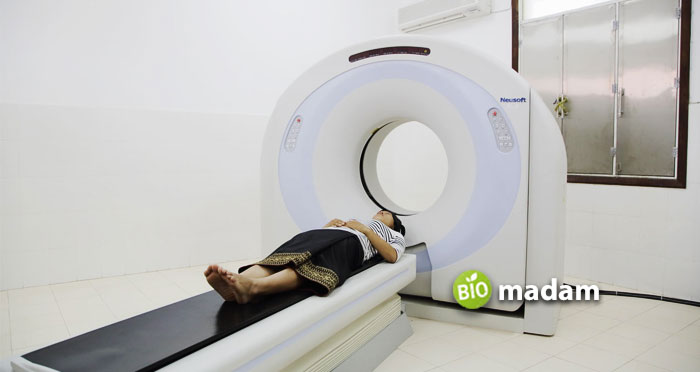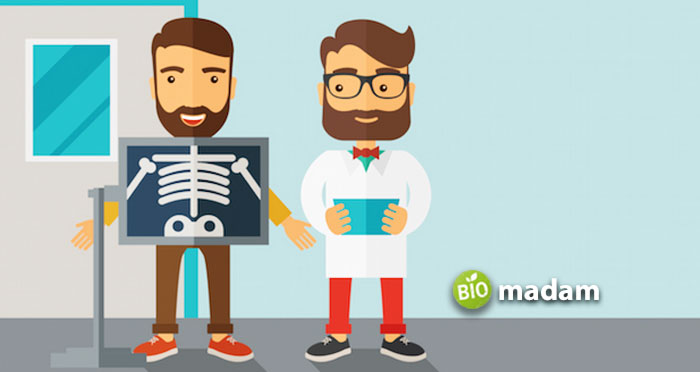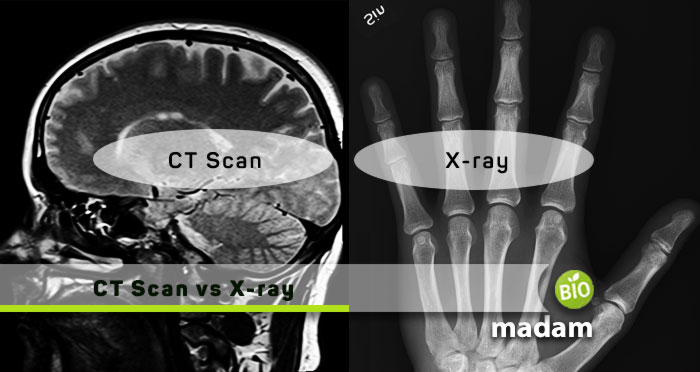X-rays and CT scans are among the many diagnostic tests performed in the laboratory for infection and disease diagnosis. They are typically used to locate a disease according to its signs or symptoms. While many people get one or both tests done per need, they are not aware of the identity of the two. The main difference between an X-ray and a CT scan is the output. An X-ray gives a 2D image, whereas a CT gives a 3D image of the desired area. X-rays are more common than CT scans. But, your doctor may suggest a CT scan if they think you need thorough, 3D imaging for proper examination.
Let’s dive into the details of X-rays and CT scans for easy understanding.
Comparison Table
| Characteristics | CT Scan | X-ray |
| Definition | Detailed 3D view | Imaging through x-rays |
| Types | Pelvic, cardiac, angiography | Head, bone, chest |
| Examination | Soft tissue, bones, blood vessels, etc. | Dense tissues |
| Imaging | Multiple | Single |
| Imaging dimension | 3D | 2D |
| Equipment | Huge | Less complex |
| Cost | Costlier | Less expensive |
| Order of choice | Second | First |
What is a CT Scan?
Computed Tomography, also known as a CT scan, is a detailed viewing of the inside of the body. It is similar to an X-ray but differs from MRI technology. A CT scan uses several X-rays at once to provide 3D images of a particular area. The machine consists of a table that goes into a tube. It is a painless procedure that takes around 15 seconds to capture multiple images. These images are then combined into a collage for easy observation. The doctor may study them individually as well. CT scans are more specific than an X-ray. They can detect the nature and location of an abnormality present.

Types of CT Scan
CT scans help diagnose abdominal, chest, head, and cardiac issues. Doctors suggest one of these CT scans usually:
Head CT Scan
A Head CT scan is ordered to rule out the risk of stroke or tumor, either benign or malignant. Your doctor might suggest a CT scan if you are experiencing dizziness or a headache. The CT scan takes images of the brain and the sinuses to help diagnose the possible pathology. Studying the sinuses allows the healthcare practitioner to observe the presence of inflammation.
Abdominal CT Scan
An abdominal CT scan takes images of the digestive system organs like the colon, small and large intestines, liver, spleen, and appendix. It helps diagnose tumors in the affected area and detect internal bleeding. One of the common applications of the abdominal CT scan is diagnosing colon cancer.
CT Angiography
A CT angiography can be of great help compared to X-rays and MRIs. It allows doctors to detect damage to the arteries and veins, or heart diseases. It usually requires an IV contrast to study the flow of blood easily. The images of the blood vessels are combined to study and catch the problem.
Chest CT Scan
A chest CT scan resembles a chest X-ray. However, it provides more detailed, 3D images of the area under study. Doctors order chest CT scans when the patient complains of breathing problems or pain. A chest CT scan provides various images of the chest for accurate diagnosis. They are effective in diagnosing diseases like asthma, bronchitis, pneumonia, tuberculosis, and lung cancer. It can also detect the presence of fluids in the lungs.
Pelvic CT Scan
A pelvic CT scan gives pictures of the pelvic area to evaluate reproductive issues in males and females. It refers to examining the area between the hip bones through multiple X-rays. A pelvic CT scan can also help with diagnosing bladder cysts, tumors, or stones.
What is an X-ray?
An X-ray is a medical diagnostic procedure that uses X-rays or electromagnetic rays to detect an injury or disease. It gives a 2D image of the body part under study. Chest X-rays are the most extensively performed type of X-ray. If performed by an RRT or a CRT, they help understand a person’s respiratory disease or condition and rule out the chances of chest infections, like tuberculosis. Your physician may also carry out an X-ray to find a fracture. An X-ray is a quick procedure and does not take a lot of time. It takes only 15 minutes to give an image of the body area under observation. An X-ray uses a small amount of radiation and does not cause pain.

Types of X-ray
There are several different types of X-rays depending on the purpose of the test. Some of the common types of X-rays are:
Chest X-ray
A chest X-ray is one of the most widely prescribed X-rays. They aid in the diagnosis of pneumonia, tuberculosis, etc. It helps the physician understand chest issues and examine the heart and lungs.
Abdominals X-ray
Abdominal X-rays give a complete view of the abdomen to study the functioning of kidneys, stomach, liver, and bladder. They prove to be of high importance in diagnosing kidney stones besides through the kidney stone size chart. Some abdominal X-rays like ureters, kidneys, and bladder require IV contrast preparation.
Bone X-ray
X-rays are widely used to evaluate fractures in bones. They also facilitate the diagnosis of osteoarthritis, rheumatoid arthritis, and dislocated bones. Observations through a bone X-ray may also indicate bone cancer.
Dental X-rays
When you visit a dentist, they mostly ask you to get an X-ray first. It enables them to find the cause of pain or loosening of the tooth to look for the right treatment methods. They are essential for finding out infections and cavities in the mouth.
Similarities Between an X-ray and a CT Scan
- An X-ray and CT scan uses X-rays to produce images of the desired areas.
- They are used in the diagnosis of diseases in tissues and bones.
- Both of them help detect abnormalities in the head, chest, bones, etc.
- They are not painful.
- These diagnostic tests take around 15 minutes only.
Differences Between X-ray and CT Scans
Definition
CT Scan
A CT scan provides more detailed internal images for improved accuracy.
X-ray
An X-ray uses electromagnetic radiation to provide internal images of the body.
Types
CT Scan
Pelvic, cardiac, angiography and head CT scans are mostly used in diagnosis.
X-rays
On the other hand, commonly prescribed X-rays are chest X-rays, bone X-rays, and head X-rays.
Examination
CT Scan
Another major difference between CT scans and X-ray is their ability to observe tissues. CT scans can observe soft tissues, bones, and blood vessels simultaneously.
X-ray
Contrarily, X-rays are more helpful in examining dense tissues.
Imaging
CT Scan
Whereas a CT scan gives you multiple images from various dimensions for easy evaluation.
X-ray
X-rays give a single image of the studied organ or system.
Imaging Dimension
CT Scan
CT scans provide a 3D image for in-depth analysis.
X-ray
However, an X-ray provides a 2D image of the organ or organ system.
Equipment
CT Scan
The CT Scan machine looks like a tube and is larger than an X-ray machine.
X-ray
Alternatively, the X-ray equipment is smaller compared to the CT scan machine.
Cost
CT Scan
CT scans are more expensive than X-rays. They are the second choice of diagnostic tests after an X-ray.
X-ray
At the same time, an X-ray is usually a low-cost, initial diagnostic test.
The Bottom Line
X-rays and CT scans are crucial diagnostic tests that help in detecting diseases. They are usually carried out to diagnose injuries, diseases, and tumors in the brain, left and right lungs, colon, etc. One of the major differences between a CT scan and an X-ray is their imagining dimension. X-rays provide a 2D image, whereas CT scan gives a 3D image. CT scans provide a more clear image and accurate location of the issue.
FAQs
What is a mammogram?
Mammograms are diagnostic tests used to take X-rays of breast tissue to diagnose lumps and breast cancer.
What is a CT scan vs. MRI?
CT scans use X-rays to diagnose disease through imaging, whereas MRI uses radio waves and magnetic fields to produce more detailed images.
What is the difference between MRI and X-ray?
X-rays have ionizing radiation, while MRIs use radio waves. An MRI usually takes around 30 minutes for an MRI. On the contrary, an X-ray takes only fifteen minutes.

Anna has completed her degree in Pharmacy from the University of Hawaii. She is serving as a research assistant in a pharmaceutical company. She had a great interest in writing blogs, traveling to different parts of the US, and trying delicious recipes in her spare time.

